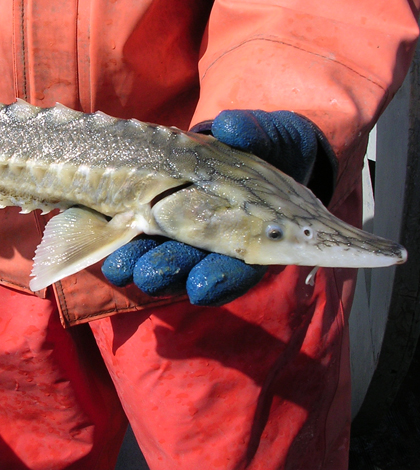Threatened green sturgeon especially prone to getting sucked up irrigation pipes

A juvenile green sturgeon (Credit: California Department of Water Resources)
There are more than 3,300 unscreened water intake pipes along the banks of the Sacramento River in California. The pipes mostly take in water for irrigating crops, but they’re also good at taking in fish that swim by.
Some are strong enough to swim through the pulling suction of a pipe. But as researchers from the University of California – Davis found, others are not. When these fish are pulled up, they end up in drainage ditches where they eventually die.
It’s impossible to measure the risk that each and every fish species has of being pulled up by the pipes, so researchers focused on just one — the threatened green sturgeon.
The study dipped into the university’s experimental stock of juvenile green sturgeon. The researchers introduced the fish into a flume used to replicate typical conditions of the Sacramento River while an unscreened pipe mimicked those in the real world.
Cameras captured what happened as they got nearer to the pipe. Based on past experiments with other fish species, including Chinook salmon, researchers expected that some of the fish would get caught.
“We thought they’d be susceptible (to being sucked up by the pipe), but we didn’t think they’d be as susceptible as we found,” said Nann Fangue, assistant professor in the Department of Wildlife, Fish and Conservation Biology. “The very first time we did it, all the sturgeon were sucked up in one hour.”
Video from the study shows juvenile green sturgeon getting sucked up into the experimental intake pipe.
So the experiment was tweaked. The goal wasn’t just to see how many sturgeon would be taken in, but also to find solutions to help the fish avoid entrainment. They tried out varying flow speeds while regulating the intake pipe suction. Sontek ADV 3D velocity probes let them chart how fast water was moving.
But across the varied experimental conditions, researchers found that baby green sturgeon are still more likely to get pulled up by unscreened intake pipes. It may be that they swim too close to the pipes. After all, most intakes are set near the streambed, and sturgeon are bottom-feeding fish.
“There’s also the hypothesis that they’re quite ancient; that they’re not as advanced,” said Fangue. “Salmon may have advantages by comparison.”
Or it could just be that juvenile sturgeon are more at risk because they haven’t grown into strong swimmers.

Water intake pipes along the Sacramento River (Credit: Fangue Lab at UC Davis)
Fangue and others have looked at ways to protect the sturgeon from entrainment. Behavioral deterrents could be beneficial, like some sort of vibration or visual cue to scare fish away from the pipes. Putting intakes in higher flow areas could make a difference. Fish are more likely get taken in low flow areas because they “mill around more,” according to Fangue.
Simply screening the pipes doesn’t do much good because the suction will still be there. Fish could still get trapped to the screen. Nor does it seem like there would be much support from irrigators who would have to install and maintain the screens. Fangue says the best option at this point is to lower the speed of the intake.
“If an irrigator wants to extract 10 gallons, is it better to do that slowly over a long period or fast over a short period?” said Fangue. “Actually, slower over a long period is better.”
Top image: A juvenile green sturgeon (Credit: California Department of Water Resources)




0 comments